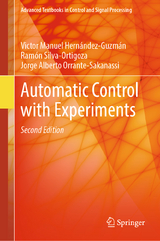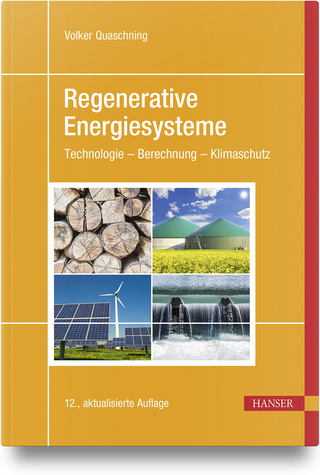
Automatic Control with Experiments
Springer International Publishing (Verlag)
978-3-319-75803-9 (ISBN)
- Titel erscheint in neuer Auflage
- Artikel merken
This textbook presents theory and practice in the context of automatic control education. It presents the relevant theory in the first eight chapters,
applying them later on to the control of several real plants. Each plant is studied following a uniform procedure: a) the plant's function
is described, b) a mathematical model is obtained, c) plant construction is explained in such a way that the reader can build his or her own plant to conduct experiments, d) experiments are conducted to determine the plant's parameters, e) a controller is designed using the theory discussed in the first eight chapters, f) practical controller implementation is performed in such a way that the reader can build the controller in practice, and g) the experimental results are presented. Moreover, the book provides a wealth of exercises and appendices reviewing the foundations of several concepts and techniques in automatic control. The control system construction proposed is based on inexpensive, easy-to-use hardware. An explicit procedure for obtaining formulas for the oscillation condition and the oscillation frequency of electronic oscillator circuits is demonstrated as well.
Prof. Dr. Victor Manuel Hernández-Guzmán is a Professor at Universidad Autonoma de Queretaro, Mexico, since 1995, where he teaches Classical and Modern (Linear and Nonlinear) Control in undergraduate and graduate academic programs. He is a researcher in the Automatic Control Systems field. Prof. Dr. Ramón Silva-Ortigoza has been a Researcher at the Department of Mechatronics, CIDETEC-IPN, since 2006, being the author of several books in English and Spanish. His research interests include mechatronic control systems, mobile robotics, control in power electronics, and development of educational technology.
1. Introduction
1.1 An anti-aircraft gun control system
1.2 History of automatic control
1.3 Didactic prototypes
2. Physical system modeling
2.1 Mechanical systems
2.1.1 Translational mechanical systems
2.1.2 Rotative mechanical systems
2.2 Electrical systems
2.3 Transformers2.3.1 Electric transformer
2.3.2 Gear reducer
2.3.3 Rack and pinion
2.4 Converters
2.4.1 Armature of a permanent magnet brushed DC motor2.4.2 Electromagnet
2.5 A case of study. A DC-to-DC high-frequency series resonant power converter
2.6 Exercises
3. Ordinary linear differential equations
3.1 First order differential equation
3.1.1 Graphical study of the solution
3.1.2 Transfer function
3.2 An integrator3.3 Second order differential equation
3.3.1 Graphical study of solution
3.3.2 Transfer function
3.4 Arbitrary order differential equations
3.4.1 Real and different roots
3.4.2 Real and repeated roots
3.4.3 Complex conjugated and not repeated roots
3.4.4 Complex conjugated and repeated roots
3.4.5 Conclusions
3.5 Poles and zeros in higher-order systems
3.5.1 Pole-zero cancellation and reduced order models
3.5.2 Dominant poles and reduced order models
3.5.3 Approximating transitory response of higher-order systems3.6 The case of sinusoidal excitations
3.7 The superposition principle
3.8 Controlling first and second order systems
3.8.1 Proportional control of velocity in a DC motor3.8.2 Proportional position control plus velocity feedback for a DC motor
3.8.3 Proportional-derivative position control of a DC motor
3.8.4 Proportional-integral velocity control of a DC motor
3.8.5 Proportional, PI and PID control of first order systems3.9 Case of study. A DC-to-DC high-frequency series resonant power electronic converter
3.10 Exercises
4. Stability criteria and steady state error
4.1 Block diagrams4.2 Rule of signs
4.2.1 Second degree polynomials
4.2.2 First degree polynomials
4.2.3 Polynomials with degree greater than or equal to 34.3 Routh's stability criterion
4.4 Steady state error
4.4.1 Step desired output
4.4.2 Ramp desired output
4.4.3 Parabola desired output4.5 Exercises
5. Time response-based design
5.1 Drawing the root locus diagram
5.1.1 Rules to draw the root locus diagram5.2 Root locus-based analysis and design
5.2.1 Proportional control of position
5.2.2 Proportional-derivative (PD) control of position
5.2.3 Position control using a lead-compensator5.2.4 Proportional-integral (PI) control of velocity
5.2.5 Proportional-integral-derivative (PID) control of position
5.2.6 Assigning the desired closed-loop poles
5.2.7 Proportional-integral-derivative (PID) control of an unstable plant5.2.8 Control of a ball and beam system
5.2.9 Assigning the desired poles for a ball and beam system
5.3 Case of study. Additional notes on PID control of position for a permanent magnet brushed DC motor
5.4 Exercises
6. Frequency response-based design
6.1 Frequency response of some electric circuits
6.1.1 A series RC circuit: output at capacitance
6.1.2 A series RC circuit: output at resistance6.1.3 A series RLC circuit: output at capacitance
6.1.4 A series RLC circuit: output at resistance
6.2 Relationship between frequency response and time response
6.2.1 Relationship between time response and frequency response6.3 Common graphical representations
6.3.1 Bode diagrams
6.3.2 Polar plots
6.4 Nyquist stability criterion6.4.1 Contours around poles and zeros
6.4.2 Nyquist path
6.4.3 Poles and zeros
6.4.4 Nyquist criterion. A special case6.4.5 Nyquist criterion. The general case
6.5 Stability margins
6.6 Relationship between frequency response and time response
6.6.1 Closed-loop frequency response and closed-loop time response
6.6.2 Open-loop frequency response and closed-loop time response6.7 Analysis and design examples
6.7.1 Analysis of a nonminimum phase system
6.7.2 A ball and beam system
6.7.3 PD position control of a DC motor6.7.4 PD position control redesign for a DC motor
6.7.5 PID position control of a DC motor
6.7.6 PI velocity control of a DC motor
6.8 Case of study. PID control of an unstable plant6.9 Exercises
7. The state variables approach
7.1 Definition of state variables
7.2 Approximate linearization of nonlinear state equations7.2.1 Procedure for first order state equations without input
7.2.2 General procedure for arbitrary order state equations with arbitrary number of inputs
7.3 Some results from linear algebra
7.4 Solution of a linear time invariant dynamical equation7.5 Stability of a dynamical equation
7.6 Controllability and observability
7.6.1 Controllability
7.6.2 Observability
7.7 Transfer function of a dynamical equation7.8 A realization of a transfer function
7.9 Equivalent dynamical equations
7.10 State feedback control
7.11 State observers
7.12 The separation principle7.13 Case of study. The inertial wheel pendulum
7.13.1 Obtaining forms in (7.57)
7.13.2 State feedback control
7.14 Exercises
8. Advanced topics in control
8.1 Structural limitations in classical control
8.1.1 Open-loop poles at origin
8.1.2 Open-loop poles and zeros located out of origin
8.2 Differential flatness
8.3 Describing function analysis
8.3.1 The dead zone nonlinearity [3], [4]
8.3.2 An application example
8.3.3 The saturation nonlinearity [3], [4]8.3.4 An application example
8.4 The sensitivity function and some limitations when controlling unstable plants
9. Feedback electronic circuits
9.1 Reducing effects of nonlinearities in electronic circuits9.1.1 Reducing distortion in amplifiers
9.1.2 Dead zone reduction in amplifiers
9.2 Analogue controllers with operational amplifiers
9.3 Design of sinusoidal waveform oscillators9.3.1 Design based on an operational amplifier. Wien bridge oscillator
9.3.2 Design based on an operational amplifier. Phase shift oscillator
9.3.3 A transistor-based design
9.4 A regenerative radio-frequency (RF) receiver
10. Velocity control of a PM Brushed DC motor
10.1 Mathematical model
10.2 Power amplifier
10.3 Electric current control10.4 Identification
10.5 Velocity control
10.5.1 A modified PI controller
10.5.2 A two-degrees-of-freedom controller
10.6 Experimental prototype10.6.1 Electric current control
10.6.2 Power amplifier
10.7 Experimental results
10.8 Microcontrolller PIC16F877A programming
10.9 Frequency response-based design10.9.1 Model identification
10.9.2 Proportional-integral control design
10.9.3 Prototype construction
11. Position control of a PM Brushed DC motor
11.1 Identification
11.2 Position control when disturbances are not present (Tp = 0)
11.2.1 Proportional position control with velocity feedback
11.2.2 A lead-compensator11.3 Control under effect of external disturbances
11.3.1 A modified PID controller
11.3.2 A two-degrees-of-freedom controller
11.3.3 A classical PID controller11.4 Trajectory tracking
11.5 Prototype construction
11.6 Microcontroller PIC16F877A programming
11.7 Personal computer-based control
11.8 Frequency response-based design11.8.1 Model identification
11.8.2 Proportional-integral-derivative control design
11.8.3 Prototype construction
12. Control of a servomechanism with flexibility
12.1 Mathematical model
12.2 Experimental Identification
12.3 Controller design
12.3.1 Multi-loop control
12.3.2 Direct control of th212.4 Experimental prototype construction
12.5 Microcontroller PIC16F877A C program
12.6 Personal computer Builder C++ program
13. Control of a magnetic levitation system
13.1 Complete nonlinear mathematical model
13.2 Approximate linear model
13.2.1 A state variables representation model
13.2.2 Linear approximation
13.3 Experimental prototype construction13.3.1 Ball
13.3.2 Electromagnet
13.3.3 Position sensor
13.3.4 Controller
13.3.5 Electric current loop
13.3.6 Power amplifier
13.4 Experimental identification of model parameters
13.4.1 Electromagnet internal resistance, R
13.4.2 Electromagnet inductance, L(y)13.4.3 Position sensor gain, As
13.4.4 Ball mass, m
13.5 Control system structure
13.5.1 Internal current loop13.5.2 External position loop
13.6 Controller design
13.6.1 PID position controller design using root locus
13.6.2 Design of the PI electric current controller <
13.6.3 Some experimental tests
13.6.4 PWM power amplifier
13.6.5 Design of the PID position controller using the frequency response
13.6.6 Some other experimental tests
13.6.7 An alternative procedure to design the PI electric current controller
14. Control of a ball and beam system
14.1 Mathematical model
14.1.1 Nonlinear model <
14.1.2 Linear approximate model
14.2 Prototype construction
14.2.1 Ball position x measurement system
14.2.2 Beam angle th measurement system
14.3 Parameter identification14.3.1 Motor-beam subsystem
14.3.2 Ball dynamics
14.4 Controller design
14.5 Experimental results
14.6 Control system electric diagram14.7 Builder 6 C++ code used to implement control algorithms
14.8 PIC C code used to program microcontroller PIC16F877A
14.9 Control based on a PIC16F877A microcontroller
14.9.1 Prototype construction14.9.2 Controller design
14.9.3 Experimental results
14.9.4 PIC16F877A microcontroller programming
15. Control of a Furuta pendulum
15.1 Mathematical model
15.2 A controller to swing up the pendulum
15.3 Linear approximate model
15.4 A differential flatness based model
15.5 Parameter identification15.6 Design of a stabilizing controller
15.7 Experimental tests
15.8 Control system construction
15.9 Sampling period selection
15.10 The Builder 6 C++ program
15.11 The PIC16F877A microcontroller C program
16. Control of an inertia wheel pendulum
16.1 Inertia wheel pendulum description
16.2 Mathematical model
16.3 Swing up nonlinear control16.4 Balancing controller
16.5 Prototype construction and parameter identification
16.6 Controller implementation
16.7 Experimental results
Appendices
A Fourier and Laplace transforms
A.1 Fourier series
A.2 Fourier transform
A.3 Laplace transform
B Bode diagrams
B.1 First order terms
B.1.1 A differentiator
B.1.2 An integratorB.1.3 A first order pole
B.1.4 A first order zero
B.1.5 A second order transfer function
B.1.6 A second order zero
C Decibels, dB
D Magnetically coupled coils
D.1 Invertance
D.2 Coil polarity marks
E Euler-Lagrange equations submitted to constraints
F Numerical implementation of controllers
F.1 Numerical computation of integral
F.2 Numerical differentiationF.3 Lead compensator
F.4 Controller in fig. 14.8(a)
F.4.1 Controllers in (12.37) and (12.40)
| Erscheinungsdatum | 23.08.2018 |
|---|---|
| Reihe/Serie | Advanced Textbooks in Control and Signal Processing |
| Zusatzinfo | XVI, 992 p. 633 illus., 91 illus. in color. |
| Verlagsort | Cham |
| Sprache | englisch |
| Maße | 155 x 235 mm |
| Gewicht | 1670 g |
| Themenwelt | Technik ► Elektrotechnik / Energietechnik |
| Schlagworte | automatic control textbook • Classical control • Controller practical implementation • Control of electromechanical systems • Control of Mechanical Systems • Control systems design and construction • Control systems experimental tests • Feedback electronic circuits • limit cycles • low-cost control system • State variable approach • Structural limitations in classical control |
| ISBN-10 | 3-319-75803-9 / 3319758039 |
| ISBN-13 | 978-3-319-75803-9 / 9783319758039 |
| Zustand | Neuware |
| Informationen gemäß Produktsicherheitsverordnung (GPSR) | |
| Haben Sie eine Frage zum Produkt? |
aus dem Bereich



